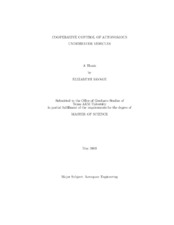| dc.contributor.advisor | Hurtado, John E. | |
| dc.creator | Savage, Elizabeth | |
| dc.date.accessioned | 2004-09-30T01:47:29Z | |
| dc.date.available | 2004-09-30T01:47:29Z | |
| dc.date.created | 2003-05 | |
| dc.date.issued | 2004-09-30 | |
| dc.identifier.uri | https://hdl.handle.net/1969.1/236 | |
| dc.description.abstract | The proposed project is the simulation of a system to search for air vehicles which
have splashed-down in the ocean. The system comprises a group of 10+ autonomous
underwater vehicles, which cooperate in order to locate the aircraft. The search algorithm
used in this system is based on a quadratic Newton method and was developed
at Sandia National Laboratories. The method has already been successfully applied
to several two dimensional problems at Sandia.
The original 2D algorithm was converted to 3D and tested for robustness in the
presence of sensor error, position error and navigational error. Treating the robots as
point masses, the system was found to be robust for all such errors.
Several real-life adaptations were necessary. A round-robin communication strategy
was implemented on the system to properly simulate the dissemination of information
throughout the group. Time to convergence is delayed but the system still
functioned adequately.
Once simulations for the point masses had been exhausted, the dynamics of the
robots were included. The robot equations of motion were described using Kane's
equations. Path-planning was investigated using optimal control methods. The Variational
Calculus approach was attempted using a line search tool "fsolve" found in
Matlab and a Genetic Algorithm. A dynamic programming technique was also investigated using a method recently developed by Sandia National Laboratories. The Dynamic
Programming with Interior Points (DPIP) method was a very effcient method
for path planning and performed well in the presence of system constraints.
Finally all components of the system were integrated. The motion of the robot
exactly matched the motion of the particles, even when subjected to the same robustness
tests carried out on the point masses. This thesis provides exciting developments
for all types of cooperative projects. | en |
| dc.format.extent | 861698 bytes | en |
| dc.format.extent | 125843 bytes | en |
| dc.format.medium | electronic | en |
| dc.format.mimetype | application/pdf | |
| dc.format.mimetype | text/plain | |
| dc.language.iso | en_US | |
| dc.publisher | Texas A&M University | |
| dc.subject | autonomous | en |
| dc.subject | AUV | en |
| dc.subject | cooperative control | en |
| dc.subject | dynamic programming | en |
| dc.subject | genetic algorithms | en |
| dc.subject | optimal control | en |
| dc.subject | underwater search | en |
| dc.title | Cooperative control of autonomous underwater vehicles. | en |
| dc.type | Book | en |
| dc.type | Thesis | en |
| thesis.degree.department | Aerospace Engineering | en |
| thesis.degree.discipline | Aerospace Engineering | en |
| thesis.degree.grantor | Texas A&M University | en |
| thesis.degree.name | Master of Science | en |
| thesis.degree.level | Masters | en |
| dc.contributor.committeeMember | Junkins, John | |
| dc.contributor.committeeMember | Swaroop, Darbha | |
| dc.contributor.committeeMember | Valasek, John | |
| dc.type.genre | Electronic Thesis | en |
| dc.type.material | text | en |
| dc.format.digitalOrigin | born digital | en |


